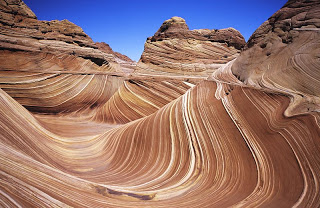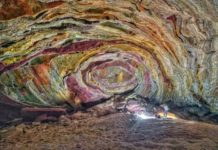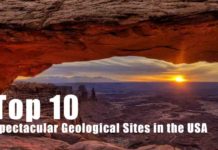
Discovering the Mystical Beauty of The Wave, Arizona
Nestled within the vast and rugged landscape of the Vermilion Cliffs National Monument in northern Arizona lies a geological wonder that has captivated the imaginations of nature enthusiasts and adventurers alike – The Wave. This surreal and otherworldly sandstone formation is a testament to the awe-inspiring forces of nature that have shaped the American Southwest.
Introduction to The Wave
The Wave is a striking example of nature’s artistry, a sandstone formation that undulates in a wave-like pattern, creating an almost dreamlike landscape. Situated in the Coyote Buttes area of the Vermilion Cliffs, The Wave is renowned for its unique and colorful striations, resembling a painting crafted by the hand of a master artist. Its popularity has grown exponentially, drawing visitors from around the world eager to witness this geological masterpiece.
Geological Origins
Understanding the geological origins of The Wave adds a layer of appreciation for its beauty. The formation is primarily composed of Jurassic-age Navajo Sandstone, deposited over 190 million years ago. Erosion, primarily by wind and water, has sculpted the sandstone into the undulating forms that we see today. The distinctive cross-bedding and layering tell a story of ancient dunes frozen in time, now revealed for all to marvel at.
“The Wave” consists of intersecting U-shaped troughs that have been eroded into Navajo Sandstone of Jurassic age. The two major troughs, which comprise this rock formation, are 19 meters wide by 36 meters long and 2 meters wide by 16 meters long. Initially, infrequent runoff eroded these troughs along joints within the Navajo Sandstone. After their formation, the drainage basin, which fed rainwater to these troughs, shrank to the point that the runoff became insufficient to contribute to the cutting of these troughs. As a result, the troughs are now almost exclusively eroded by wind as indicated by the orientation of erosional steps and risers cut into the sandstone along their steep walls. These erosional steps and risers are oriented relative to predominate direction of the wind as it is now naturally funneled into and through these troughs.
The Wave exposes large, eolian sets of cross-bedded sandstone composed of rhythmic and cyclic alternating grainflow and windripple laminae. The rhythmic and cyclic alternating laminae represent periodic changes in the prevailing winds during the Jurassic as huge sand dunes migrated across a sandy desert. The thin ridges and ribbing seen within The Wave are the result of the differential erosion of rhythmic and cyclic alternating grainflow and windripple laminae within the Navajo Sandstone. These laminae have differing resistance to erosion as they have been differentially cemented according to variations in the grain size of the sand composing them. The soft sandstone, including the ridges and ribbing, of The Wave is fragile. As a result, a person needs to walk carefully to not break the small ridges.
In places, The Wave exposes deformed laminae within the Navajo Sandstone. These laminae were deformed prior to the lithification of the sand to form sandstone. Judging from their physical characteristics, this deformation likely represents the trampling and churning of these sands by dinosaurs right after their deposition. Dinosaur tracks and the fossil burrows of desert-dwelling arthropods, such as beetles and other insects, have been found within the Navajo Sandstone within the North Coyote Buttes Wilderness Area.
Accessing The Wave: A Permits Challenge
The Wave’s popularity comes with a caveat – access is strictly regulated. The Bureau of Land Management (BLM) issues a limited number of permits each day to preserve the delicate environment and ensure a peaceful experience for visitors. Securing one of these coveted permits has become a challenge in itself, adding an element of exclusivity to the journey. However, the effort required to obtain a permit only amplifies the anticipation and excitement for those fortunate enough to embark on this adventure.
The Hike to The Wave
Access to The Wave involves a moderate to strenuous hike, adding a sense of adventure and accomplishment to the visit. The journey begins at the Wire Pass Trailhead, leading hikers through a maze of slickrock and sandy terrain. Navigating the path, often marked only by small cairns, enhances the feeling of discovery and exploration. The final approach to The Wave unveils the iconic formation, a reward for those who have ventured into the heart of the Coyote Buttes.
Colors of The Wave
One of The Wave’s most enchanting features is its vibrant color palette. The interplay of reds, oranges, yellows, and whites creates a mesmerizing display, especially during the golden hours of sunrise and sunset. The varying hues are a result of mineral deposits in the sandstone, with iron and manganese producing the warm tones that dance across the undulating surfaces. Photographers, in particular, find The Wave to be a captivating subject, with every angle revealing a new perspective of its kaleidoscopic beauty.
Flora and Fauna in the Desert Oasis
While the surrounding desert may appear harsh and barren, The Wave supports a surprising diversity of flora and fauna. Hardy desert plants, adapted to the arid conditions, cling to life in crevices and pockets of soil. The resilient desert tortoise and the elusive bighorn sheep are among the native inhabitants, showcasing the remarkable ability of life to thrive in seemingly inhospitable environments.
Preservation Efforts and Leave No Trace Principles
The fragility of The Wave’s ecosystem and its popularity among visitors have prompted conservation efforts to protect this natural wonder. Leave No Trace principles are emphasized, urging visitors to minimize their impact on the delicate environment. Education about responsible hiking practices and adherence to established trails help preserve The Wave for future generations, ensuring that its beauty endures.
The Wave Beyond Photography: An Artist’s Inspiration
Beyond its visual appeal, The Wave has inspired artists, writers, and creatives across disciplines. Its surreal forms and timeless beauty have been the muse for countless works of art, literature, and even scientific studies. The intersection of art and nature is vividly apparent in this remote corner of the American Southwest.
Challenges and Controversies
The popularity of The Wave has not been without challenges and controversies. The delicate balance between accessibility and preservation has led to ongoing discussions about visitor limits, permit systems, and the overall impact of human presence on this fragile landscape. Striking the right balance is crucial to ensuring the long-term sustainability of this natural treasure.
Conclusion: A Journey to Remember
In conclusion, The Wave, Arizona, stands as a testament to the raw beauty and geological wonders that grace the American Southwest. Its surreal landscapes, vibrant colors, and the sense of exclusivity granted by limited permits make it a destination like no other. The journey to The Wave is not merely a physical one; it is a voyage into the heart of Earth’s history, where the forces of time and nature have collaborated to create a masterpiece that transcends the ordinary.
As visitors marvel at the undulating sandstone and vibrant hues, The Wave remains a beacon of inspiration, reminding us of the profound beauty that can be found in the most unexpected corners of our planet. Whether captured through the lens of a camera or etched into the memory of those fortunate enough to experience it firsthand, The Wave leaves an indelible mark, inviting all who encounter it to contemplate the wonders of our natural world.










